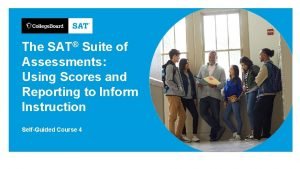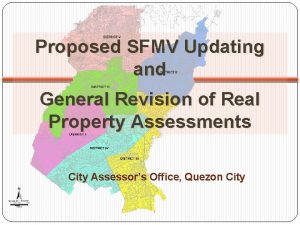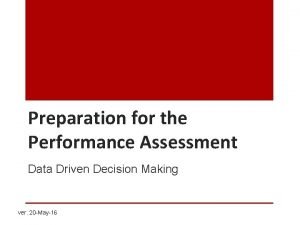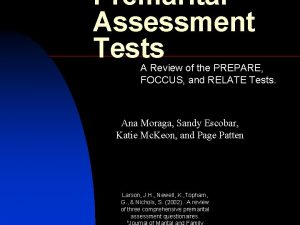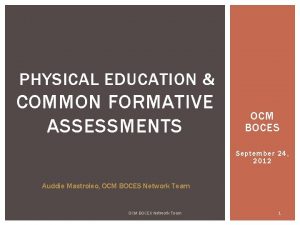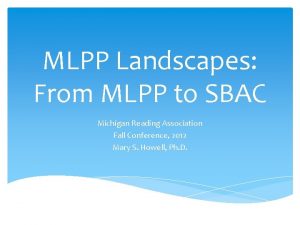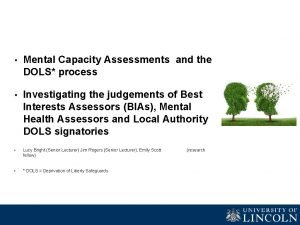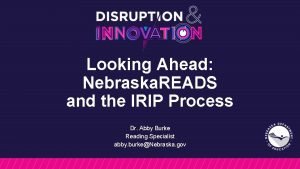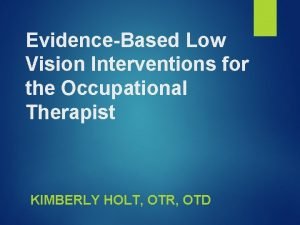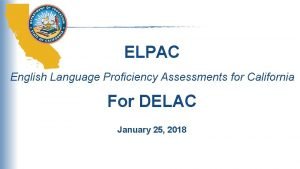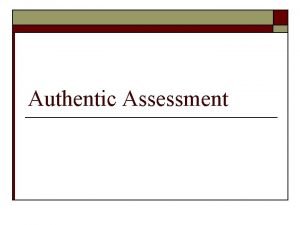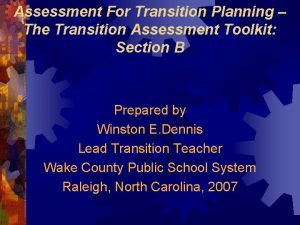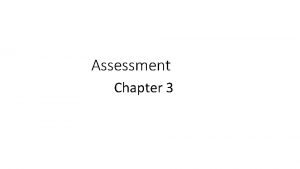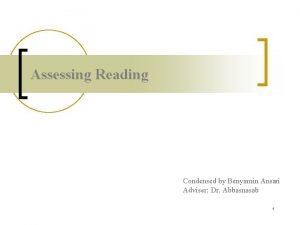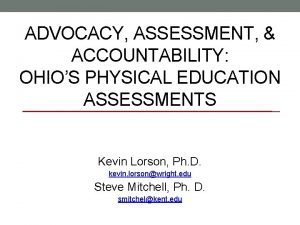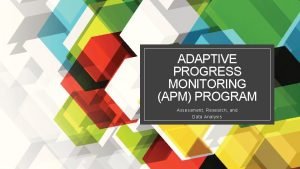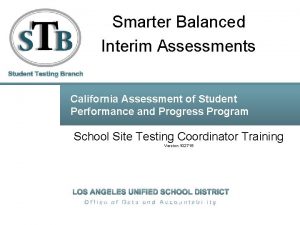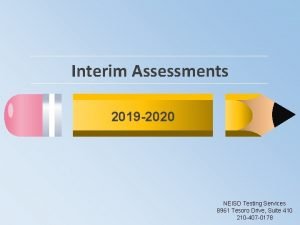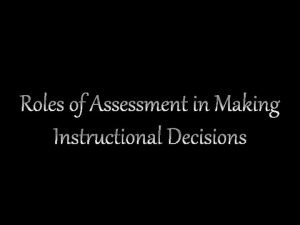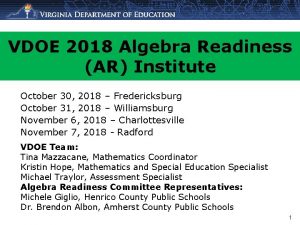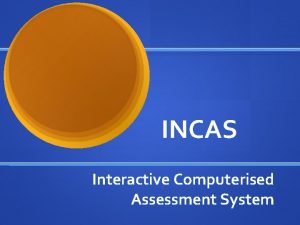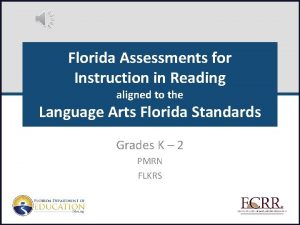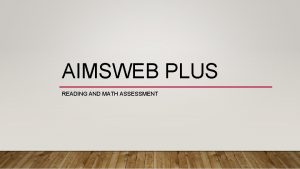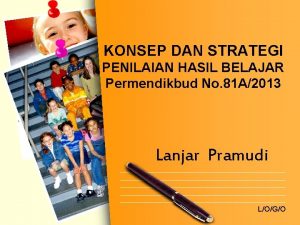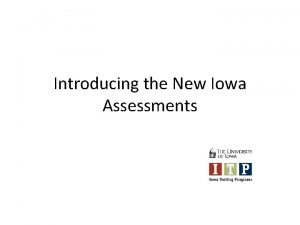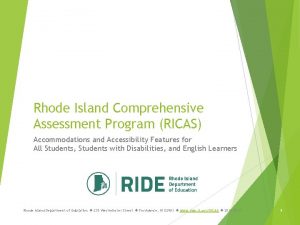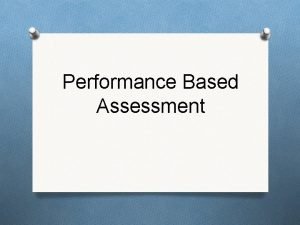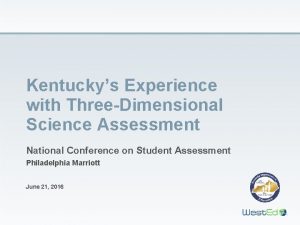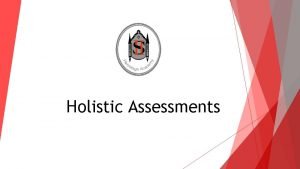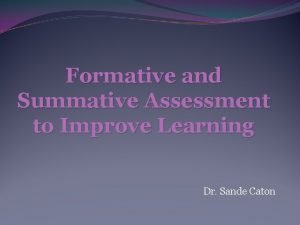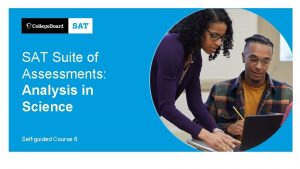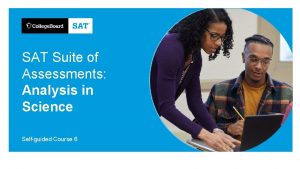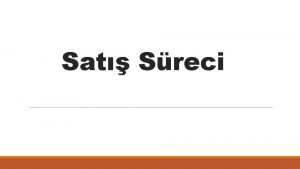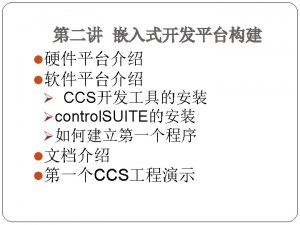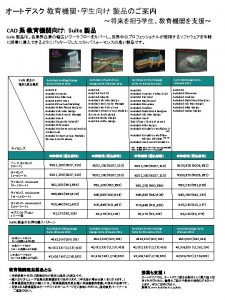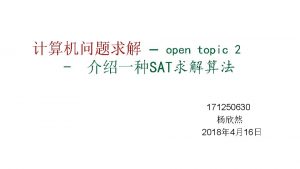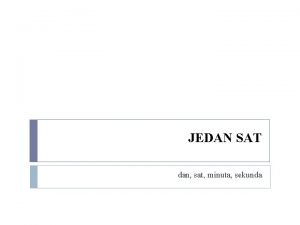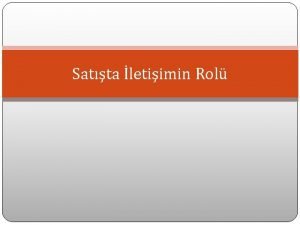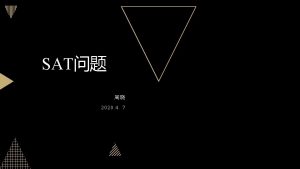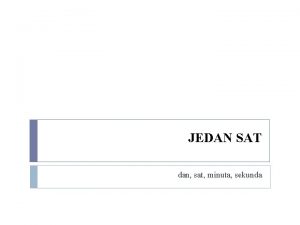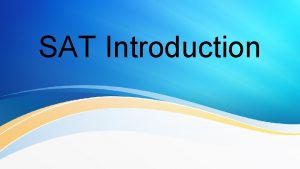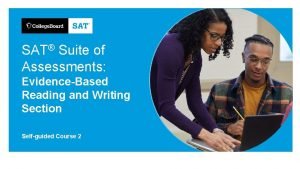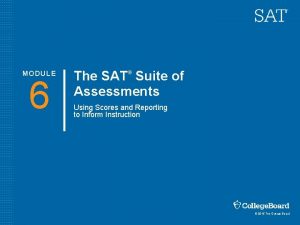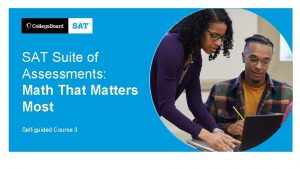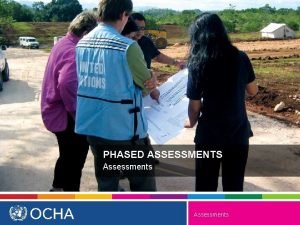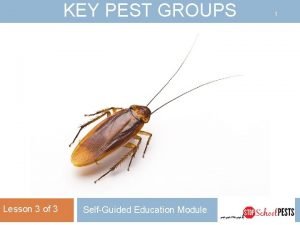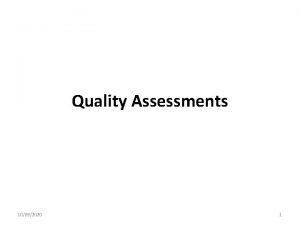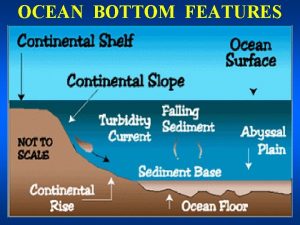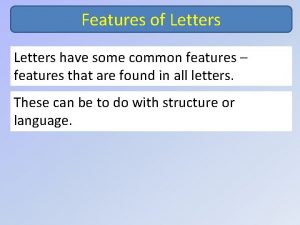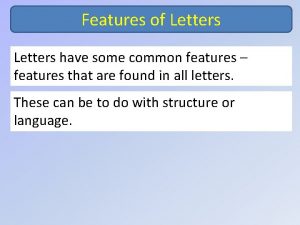The SAT Suite of Assessments Key Features SelfGuided






















![SAT Essay Prompt As you read the passage below, consider how [the author] uses SAT Essay Prompt As you read the passage below, consider how [the author] uses](https://slidetodoc.com/presentation_image_h2/970bed7078fc10c76aff4ed3c8566f13/image-23.jpg)





















- Slides: 44

The SAT® Suite of Assessments: Key Features Self-Guided Course 1 November, 2019

Self-Guided Courses for Educators for the SAT Suite of Assessments Course 1 Key Features Course 2 Evidence-Based Reading and Writing Course 3 Math That Matters Most Course 4 The SAT Suite of Assessments: Using Scores and Reporting to Inform Instruction Course 5 Connecting History/Social Studies Instruction with the SAT Suite of Assessments Course 6 Connecting Science Instruction with the SAT Suite of Assessments Course 7 The SAT Essay Course 8 Supporting Students with Official SAT Practice on Khan Academy TM 4

Objectives of Course 1 – Key Features Chapter 1

What Do Students Need to Know for Post-High-School Success? The College Board has identified a critical set of knowledge, skills, and understandings that predict student success in college and workforce training programs: • Comprehend challenging literary and informational texts • Revise and edit extended texts • Show command of math, especially algebra and data analysis • Use evidence in reading and writing • Analyze data • Use and understand words in context 7

The SAT® Suite of Assessments 8

™ PSAT 10 and PSAT/NMSQT ® 9

PSAT™ 8/9 ? ? ? WHO WHERE WHEN 8 th and 9 th Graders in schools Fall or Spring Administration 10

The SAT Suite of Assessments: Format and Structure Chapter 2

Format of the SAT® Suite of Assessments SAT ® PSAT™-Related Assessments Evidence Based Reading and Writing Section Reading Test Writing and Language Test Math Section Math Test No Calculator Portion Calculator. Allowed Portion Essay – SAT ® ONLY 12

Test Length and Timing Reading Test Writing and Language Test Math Test Calculator Total Length Total Questions Time Allotted (in minutes) Total Questions Essay No Calculator Time Allotted Total 1 Time Allotted Questions (in (in minutes) SAT 3 hours (+50 minutes, optional Essay) 52 65 44 35 38 55 20 25 PSAT/NMST and PSAT 10 2 hours, 45 minutes 47 60 44 35 31 45 17 25 N/A PSAT 8/9 2 hours, 25 minutes 42 55 40 30 25 40 13 20 N/A 50 13

Key Features of the SAT® Words in Context Analysis in Science and in History/Social Studies Command of Evidence U. S. Founding Documents and the Great Global Conversation Math that Matters Most Essay Analyzing a Source Problems Grounded in Real-world Contexts No Penalty for Guessing 14

Which Key Feature Will Have the Most Impact on Students?

The SAT Suite of Assessments: Knowledge and Skills Chapter 3

Evidence-Based Reading and Writing Overview • The Evidence-Based Reading and Writing Section comprises the Reading Test and the Writing and Language Test. • Text complexity: -SAT: range from 9 th grade through first-year, post high school -PSAT/NMSQT and PSAT 10: range from 9 th to 10 th grade -PSAT 8/9: range from 6 th to 10 th grade • Emphasizes source analysis and use of evidence • Incorporates data and informational graphics • Focuses on words in context and on word choice for rhetorical effect • Includes texts in literature, science, and social studies 17

SAT® Reading Test Features Single and paired passages Cross disciplinary contexts - US and world literature, History/social studies, Science. Informational graphics Focus on: § Words in context § Command of evidence 18

1 Today, I am an inquisitor. An hyperbole would not be fictional and would not overstate the solemnness that I feel right now. My faith in the Constitution is whole; it is complete; it is total. And I am not going to sit here and be 5 an idle spectator to the diminution, the subversion, the destruction, of the Constitution. “Who can so properly be the inquisitors for the nation as the representatives of the nation themselves? ” “The subjects of its jurisdiction are those offenses which 10 proceed from the misconduct of public men. ” Reading Test Sample Question– Passage (abbreviated) 19

Reading Test Sample Question The main rhetorical effect of the series of three phrases in lines 5– 6 (“the diminution, the subversion, the destruction”) is to A) convey with increasing intensity the seriousness of the threat Jordan sees to the Constitution. B) clarify that Jordan believes the Constitution was first weakened, then sabotaged, then broken. C) indicate that Jordan thinks the Constitution is prone to failure in three distinct ways. D) propose a three-part agenda for rescuing the Constitution from the current crisis. Content: Rhetoric/Analyzing word choice Objective: Students must determine the main rhetorical effect of the speaker’s choice of words. 20

Reading Test Sample Question Answer Explanation A) convey with increasing intensity the seriousness of the threat Jordan sees to the Constitution. Choice A is the best answer because the quoted phrases— building from “diminution” to “subversion” to “destruction”— suggest the increasing seriousness of the threat Jordan sees to the Constitution. 21

SAT® Writing and Language Test Features Passage based Multiple text types: argument, informative, nonfiction narrative Informational graphics Focus on: § § Expression of ideas Standard English conventions Words in context Command of evidence 22

Writing and Language Test Sample Question A 1954 documentary about renowned watercolor painter Dong Kingman shows the artist sitting on a stool on Mott Street in New York City’s Chinatown. A crowd of admiring spectators watches as Kingman squeezes dollops of paint from several tubes into a tin watercolor [2] box, from just a few primary colors, Kingman creates dozens of beautiful hues as he layers the translucent paint onto the paper on his easel. Each stroke of the brush and dab of the sponge transforms thinly sketched outlines into buildings, shop signs, and streetlamps. The street scene Kingman begins composing in this short film is very much in keeping with the urban landscapes for which he is best known. 2. A) B) C) D) NO CHANGE box. From just a few primary colors, box from just a few primary colors, box, from just a few primary colors Content: Standard English Conventions/Conventions of Punctuation Objective: Students must create two grammatically complete and standard sentences. 23

Writing and Language Test Sample Question Explanation B) box. From just a few primary colors, Choice B is the best answer because it provides punctuation that creates two grammatically complete and standard sentences. 24

SAT® Essay Features Common prompt: publicly available *Represents sound instructional model Sources are arguments written for a broad audience Emphasis on analysis of the argument (not opinion) Analytic scoring 25
![SAT Essay Prompt As you read the passage below consider how the author uses SAT Essay Prompt As you read the passage below, consider how [the author] uses](https://slidetodoc.com/presentation_image_h2/970bed7078fc10c76aff4ed3c8566f13/image-23.jpg)
SAT Essay Prompt As you read the passage below, consider how [the author] uses • • • evidence, such as facts or examples, to support claims. reasoning to develop ideas and to connect claims and evidence. stylistic or persuasive elements, such as word choice or appeals to emotion, to add power to the ideas expressed. Source Text Write an essay in which you explain how [the author] builds an argument to persuade [his/her] audience that [author’s claim]. In your essay, analyze how [the author] uses one or more of the features listed above (or features of your own choice) to strengthen the logic and persuasiveness of [his/her] argument. Be sure that your analysis focuses on the most relevant aspects of the passage. Your essay should not explain whether you agree with [the author’s] claims, but rather explain how [he/she] builds an argument to persuade [his/her] audience. 26

SAT® Math Test Features Calculator/No calculator sections Focus on application, conceptual understanding, and procedural skill and fluency Multiple question types Multistep problems Question sets 27

Math Test Sample Question Problem Solving and Data Analysis A researcher places two colonies of bacteria into two petri dishes that each have area 10 square centimeters. After the initial placement of the bacteria (t=0), the research measures and records the area covered by the bacteria in each dish every ten minutes. The data for each dish were fit by a smooth curve, as shown above, where each curve represents the area of a dish covered by bacteria as a function of time, in hours. Which of the following is a correct statement about the data above? A) At time t=0, both dishes are 100% covered by bacteria. B) At time t=0, bacteria covers 10% of Dish 1 and 20% of Dish 2. C) At time t=0. Dish 2 is covered with 50% more bacteria than Dish 1. D) For the first hour, the area covered in Dish 2 is increasing at a higher average rate than the area covered in Dish 1. 28

Math Test Sample Question Answer Explanation Choice B is the correct answer. Each petri dish has area 10 square centimeters, and so at time t = 0, Dish 1 is 10% covered 1/10 and Dish 2 is 20% covered 2/10. Thus the statement in B is true. 29

Math Test Sample Question (continued) Passport to Advanced Math (No Calculator portion) What is one possible solution to the equation This example, from the no-calculator portion of the test, requires students to look at the structure of the expression and find a way to rewrite it, again showing the link between fluency and mathematical practices. The student must transform the expression without a calculator, for example, by multiplying both sides of the equation by a common denominator as a first step to find the solution. *This is an example of a “Student-Produced Response” or grid-in question. Students won’t be given answer choices. Instead, they fill in the grid with their answers. Approximately 20% of the Math Test contains student-produced response questions. 30

Math Test Sample Question— Solution In this problem, multiplying both sides of the equation by the common denominator (x + 1)(x − 1) yields 24(x − 1) − 12(x + 1) = (x + 1)(x − 1). Multiplication and simplification then yields 12 x − 36 = x 2 − 1, or x 2 − 12 x + 35 = 0. Factoring the quadratic gives (x − 5)(x − 7) = 0, so the solutions occur at x = 5 and x = 7, both of which should be checked in the original equation to ensure that they aren’t extraneous. In this case, both values are solutions. 31

Scores and Reporting Chapter 4

SAT® Scores 33

Monitor Progress Over Time 34

Students and educators Use Benchmarks to Enhance College Readiness can track progress toward college readiness from year to year. 35

SAT® College and Career Readiness Benchmarks Ø 75% likelihood of earning at least a C in a first-semester, credit-bearing college course in a related subject Ø Set at section level Ø Grade-level benchmarks are based on expected student growth toward the SAT Benchmarks: 36

How Does the SAT Suite Relate to Instruction in Science and History/ Social Studies Courses? Cross-test scores include scores for Analysis in Science and Analysis in History/Social Studies, derived from questions on all three tests. - Some passages used for analysis on the Reading Test and the Writing and Language Test have foundations in science and history/social studies. - One passage used on the Reading Test will be a U. S. founding document or from the great global conversation, contributing to the Analysis in History/Social Studies score. - Tables, graphs, and data accompanying some passages relate to topics science and/or history/social studies. - Some math questions will have science or social science contexts. 37

K-12 Score Reporting Portal • Accesses a wide array of standard reports. • Provides benchmarks and consistent feedback to help teachers encourage and accelerate students over time. • Allows educators to drill down to the student level. • Offers guidance to help users get the report they need. 38

Select the Report for the Task at Hand 39

Help Students Prepare for the SAT Suite Chapter 5

Free, Official SAT Practice on Khan Academy® satpractice. org Full Length Practice Tests Eight official practice tests plus study and test-taking tips Video Lessons Easy-to-follow videos explain problems step by step Interactive Problems & Instant Feedback Hints, explanations, and constant progress updates to know where you stand Daily Practice App More practice available on your phone featuring questions of the day 41

Personalized SAT Practice Through Khan Academy 42

Daily Practice for the SAT ü Daily SAT practice questions ü Instant practice test scoring 43

Top 10 Things to Tell Students About the SAT 1. Register/sign up for Khan Academy. 2. Use evidence to support your arguments. 3. Build your reading stamina. 4. Always analyze the informational graphics. 5. Get excited about the U. S. founding documents. 6. Practice editing. 7. Put away the calculator (some of the time). 8. Check your answers. 9. Answer every question on the test. 10. Take the SAT! 44

Self-Assessment/Reflection 45 • What are you doing/can you do in your classroom to help students understand what they’ll see on the SAT? • Which Key Feature is the most aligned with your current instruction? • Which Key Feature is the most challenging to incorporate into your lesson planning? • What do you need to know to begin using Khan Academy with your students? • What is the first/best point of entry for including Khan Academy in your curriculum map/lesson plans? • How can you help students keep track of their own progress toward meeting the college and career ready benchmark?

Email: SATinstructionalsuppo rt@collegeboard. org Questions or Comments About This Presentation or the SAT Suite of Assessments? 46

Thank You
 Sat subscores
Sat subscores Revenue streams example business model canvas
Revenue streams example business model canvas Contoh bisnis model canvas makanan pdf
Contoh bisnis model canvas makanan pdf General revision of assessments and property classification
General revision of assessments and property classification Performance assessment examples
Performance assessment examples Premarital tests or assessments
Premarital tests or assessments Common formative assessment examples
Common formative assessment examples Poem about performance based assessment
Poem about performance based assessment Mlpp assessments
Mlpp assessments 6 assessments for dols
6 assessments for dols Nebraska reads approved assessments
Nebraska reads approved assessments Strengths and weaknesses assessment
Strengths and weaknesses assessment Ls&s low vision
Ls&s low vision Elpac images
Elpac images Cte technical skills assessments.azed.gov/student
Cte technical skills assessments.azed.gov/student Grade 8 creative arts atp
Grade 8 creative arts atp Common core institute
Common core institute Authentic assessment definition
Authentic assessment definition Informal assessments for transition planning
Informal assessments for transition planning Characteristics of psychological test
Characteristics of psychological test Cloze reading examples
Cloze reading examples Physical education assessments examples
Physical education assessments examples Fs assessments.org/apm
Fs assessments.org/apm Lausd interim assessments
Lausd interim assessments Staar interim assessments 2019-2020
Staar interim assessments 2019-2020 Formative assessments
Formative assessments Writing analytical assessments in social work
Writing analytical assessments in social work Vdoe algebra readiness
Vdoe algebra readiness Assessment activities for informative
Assessment activities for informative Incas developed ability
Incas developed ability Physical activity and physical fitness assessments grade 9
Physical activity and physical fitness assessments grade 9 Florida assessment for instruction in reading
Florida assessment for instruction in reading Ddi assessments
Ddi assessments Aimsweb plus
Aimsweb plus Strategi penilaian pembelajaran
Strategi penilaian pembelajaran Iowa assessments
Iowa assessments Sample glba risk assessments for banks
Sample glba risk assessments for banks Outmatch assessments
Outmatch assessments Ricas reference sheet
Ricas reference sheet Types of performance based assessment
Types of performance based assessment Osde assessments
Osde assessments Next generation assessments examples
Next generation assessments examples Kentucky assessments eoc
Kentucky assessments eoc Characteristics of holistic assessment
Characteristics of holistic assessment What is formative assessments
What is formative assessments
